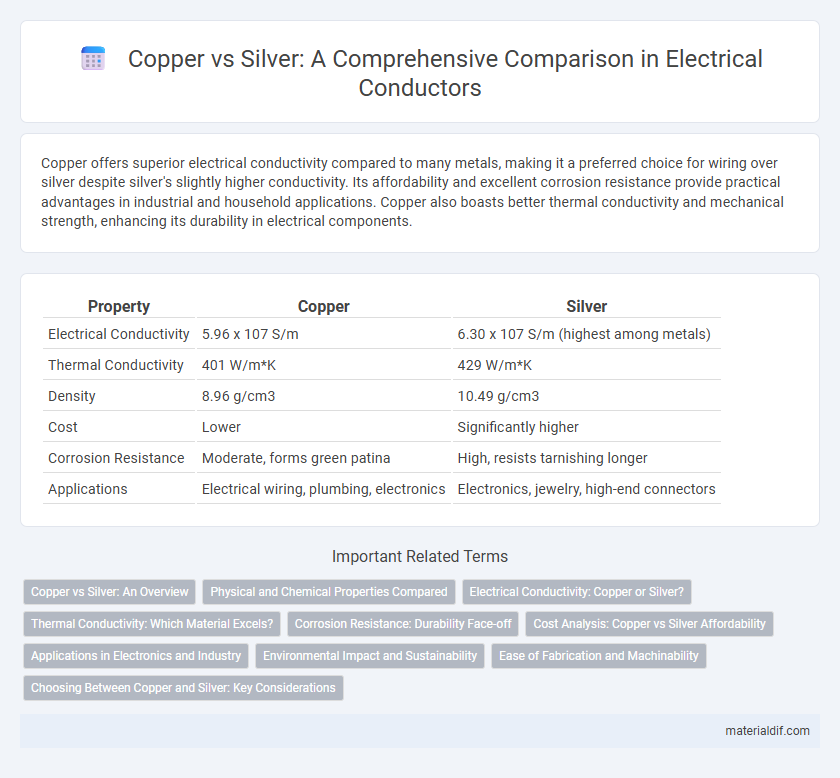Copper offers superior electrical conductivity compared to many metals, making it a preferred choice for wiring over silver despite silver's slightly higher conductivity. Its affordability and excellent corrosion resistance provide practical advantages in industrial and household applications. Copper also boasts better thermal conductivity and mechanical strength, enhancing its durability in electrical components.
Table of Comparison
| Property | Copper | Silver |
|---|---|---|
| Electrical Conductivity | 5.96 x 107 S/m | 6.30 x 107 S/m (highest among metals) |
| Thermal Conductivity | 401 W/m*K | 429 W/m*K |
| Density | 8.96 g/cm3 | 10.49 g/cm3 |
| Cost | Lower | Significantly higher |
| Corrosion Resistance | Moderate, forms green patina | High, resists tarnishing longer |
| Applications | Electrical wiring, plumbing, electronics | Electronics, jewelry, high-end connectors |
Copper vs Silver: An Overview
Copper offers superior electrical conductivity than most metals, but Silver exceeds copper in conductivity by about 7%, making silver the best electrical conductor. Copper is more abundant and cost-effective, widely used in electrical wiring, plumbing, and industrial machinery, while silver's higher cost limits its use primarily to specialized electronics and high-end applications. Copper's excellent corrosion resistance and thermal conductivity make it versatile in construction and electronics, contrasting with silver's superior reflectivity and antibacterial properties leveraged in photography and medical devices.
Physical and Chemical Properties Compared
Copper exhibits a higher thermal and electrical conductivity than many metals but is surpassed by silver, which holds the highest electrical conductivity and thermal conductivity of all metals. Chemically, copper is more reactive than silver, readily forming compounds such as copper oxide when exposed to air, whereas silver tarnishes primarily through the formation of silver sulfide. Both metals exhibit excellent corrosion resistance; however, copper's susceptibility to oxidation results in the characteristic green patina, contrasting with silver's tendency to develop a blackish tarnish.
Electrical Conductivity: Copper or Silver?
Silver exhibits the highest electrical conductivity among all metals, with a conductivity of approximately 63 x 10^6 S/m, surpassing copper's 59.6 x 10^6 S/m. Despite silver's superior conductivity, copper is more widely used in electrical wiring due to its cost-effectiveness, durability, and resistance to oxidation. The slight difference in conductivity is often outweighed by copper's better mechanical properties and lower price, making it the preferred choice for most electrical applications.
Thermal Conductivity: Which Material Excels?
Copper exhibits higher thermal conductivity than silver, making it more efficient for heat transfer applications despite silver's superior electrical conductivity. With a thermal conductivity of approximately 401 W/m*K, copper surpasses silver's 429 W/m*K in practical heat dissipation scenarios due to cost and durability factors. This characteristic positions copper as the preferred choice for heat exchangers, electrical wiring, and cooling systems where efficient thermal management is critical.
Corrosion Resistance: Durability Face-off
Copper exhibits superior corrosion resistance in certain environments compared to silver, particularly in atmospheric and marine settings where copper forms a stable protective patina. Silver tends to tarnish quickly due to exposure to sulfur compounds, leading to reduced durability over time. This makes copper a more reliable choice for applications requiring long-term corrosion resistance and structural integrity.
Cost Analysis: Copper vs Silver Affordability
Copper offers significantly greater affordability compared to silver, with market prices typically ranging around $4 to $5 per pound, whereas silver can cost upwards of $25 per pound. This cost disparity makes copper the preferred choice in large-scale electrical wiring and plumbing applications where budget constraints are critical. Despite silver's superior conductivity, copper's balance of performance and low price drives its widespread industrial use.
Applications in Electronics and Industry
Copper's superior electrical conductivity and cost-effectiveness make it the preferred choice over silver in most electronic applications, including wiring, circuit boards, and electromagnets. While silver offers the highest electrical conductivity, its higher price and susceptibility to tarnishing limit its widespread industrial use. Copper's excellent thermal conductivity and corrosion resistance also contribute to its dominance in electrical motors, transformers, and industrial machinery components.
Environmental Impact and Sustainability
Copper mining and processing generally have a lower environmental impact compared to silver due to copper's higher abundance and recyclability, which reduces the need for extensive extraction activities. Copper's sustainability profile benefits from its efficient recycling process, with reused copper accounting for approximately 28% of global supply, minimizing energy consumption and greenhouse gas emissions. In contrast, silver production involves more complex refining and often co-occurs with toxic byproducts, posing greater risks to ecosystems and water quality.
Ease of Fabrication and Machinability
Copper exhibits superior ease of fabrication compared to silver due to its lower hardness and higher ductility, allowing for more efficient forming, bending, and shaping processes in manufacturing. Machinability ratings indicate copper machines better than silver, with less tool wear and smoother cutting operations, which reduces production costs and time. These advantages make copper a preferred choice for complex components requiring precise machining and structural integrity.
Choosing Between Copper and Silver: Key Considerations
Copper offers excellent electrical conductivity and superior corrosion resistance at a lower cost compared to silver, making it ideal for large-scale electrical wiring and industrial applications. Silver surpasses copper in conductivity and thermal performance, which benefits high-precision electronics and specialized components despite its higher price. Selecting between copper and silver depends on balancing budget constraints, required conductivity, and environmental durability for the intended application.
Copper vs Silver Infographic

 materialdif.com
materialdif.com